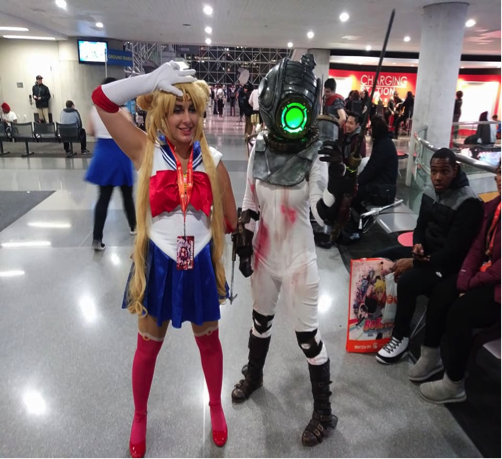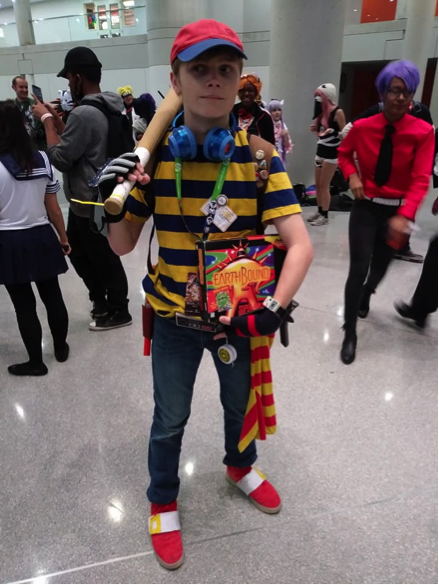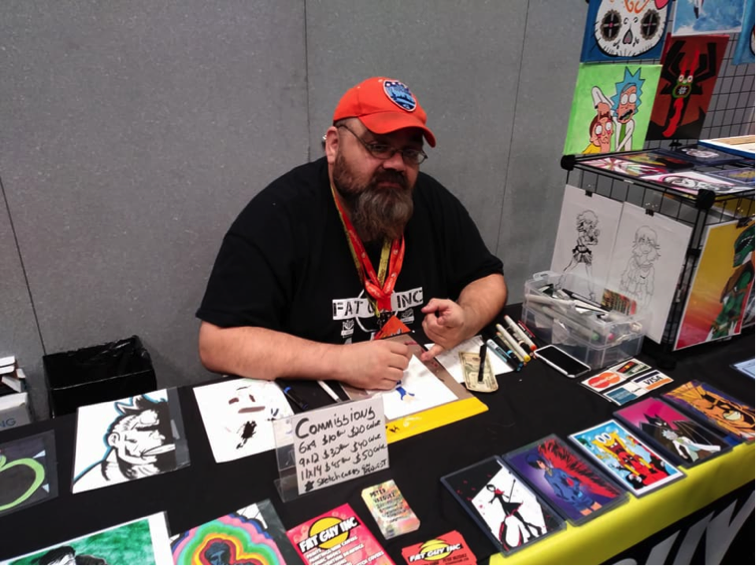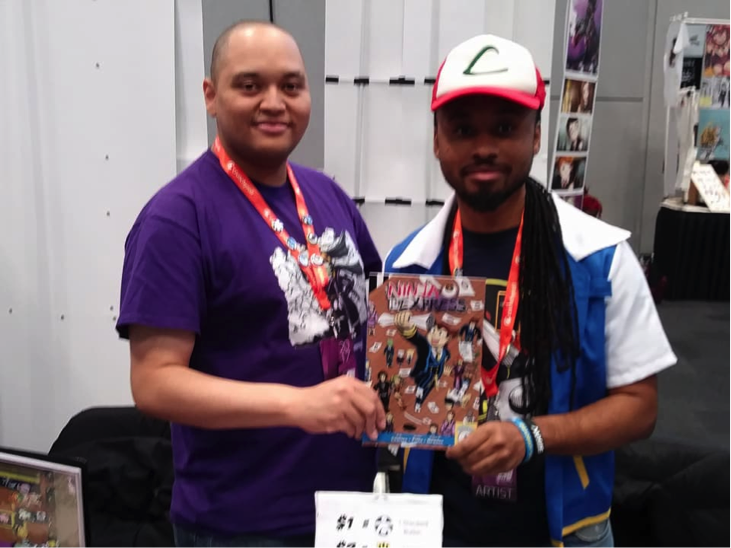For Lehman Students, Plastic Is the New Christmas Green
By Leah Liceaga
A Christmas tree lot ready for the holiday season. Photo courtesy of PublicDomainPictures.net.
“To me you’re taking away from nature every time you cut down one of those trees just to have it in your home, or anywhere else,” Christine Auiles, a Lehman English major, explained of her choice to get an artificial tree for Christmas. “They last longer, it’s more durable, [and] you can put it away until you need it.” She added that she does not feel it is necessary to have a live tree at home for Christmas when it will only last a couple of days.
For many Lehman students, like Auiles this holiday season, going for plastic was the greener and more affordable choice. According to Diffen, a website that makes comparison that people worldwide can add to and update, the price of a mid-sized artificial tree can average $100, while a real tree of the same size costs $40 to $50. A fake tree is ultimately better in the long run. The artificial tree will also last up to ten years and require less care than a real tree, which would have to be replaced every year.
Home Depot charges anywhere from $70 to over $200 for an artificial tree, depending on size and appearance -- for example, a tree covered in fake snow or already outfitted with Christmas lights would cost more than a simple artificial tree. While the real trees Home Depot sells are cheaper in the short term, over a period of years, buying multiple real trees becomes costlier than buying one artificial one.
“We got a fake tree,” Sandra Matos, a Lehman English major said of her Christmas tree choice this year. “The prices were better, and we needed one quickly.”
For other students, the issue was not price but durability. Lehman College junior, Laura Leonardo, said her family “used to get real [trees] when I was younger, but my family started getting fake ones when I got older because we got too busy to really care about Christmas like that…a fake tree, and reusing it seemed more practical.”
Buying a plastic tree gets around another problem that has increased in recent years -- a shortage of trees. Due to the recession in 2008, many people who grew Christmas trees either went out of business or had to decrease how many they grew. Since trees take a decade or so to grow, there was a shortage of Christmas trees this year.
“There is a touch of an undersupply," Doug Hundley, spokesman for the National Christmas Tree Association told Newsweek. Drought in the Pacific Northwest also shares blame for the shortage. GWD Forestry -- a company that offers direct investment into sustainably managed agroforestry plantations internationally -- predicted the recent droughts and wildfires in North Carolina and Oregon could keep the tree shortage going until the year 2025. It also noted that the amount of Christmas trees being planted across the country has dropped dramatically; falling from 5.6 million in 2010 to 3.7 million in 2015.
Once the holiday season is over, real Christmas trees are usually thrown out, though some are recycled. From Jan. 2 through 13 of 2018, the New York City Department of Sanitation (DSNY) collected real Christmas trees left at the curb and turned them into mulch to be used for the city’s parks, community gardens, and institutions. They also encouraged those with gardens to use as much of the tree as possible for mulch. The remainder of the tree could be taken to MulchFest at city parks to be chipped, or left for the DSNY to collect.
Marvel’s ‘The Punisher’ Aims High but Falters on Gun Control
By Jorel Lonesome
Logo of Marvel’s “The Punisher.” Photo courtesy of Wikipedia.
The Las Vegas Shooting on the night of Oct. 1, 2017 left the upcoming Netflix series “The Punisher” at the center of much controversy. Following the shooting, which left 58 dead and at least 527 wounded, Netflix and Marvel canceled the preview panel for the upcoming series at New York Comic Con and delayed the release of the show until a month later.
The show as it was finally released wants to be more than just another absurd action fantasy. What distinguishes it from other gun-saturated franchises is that it aims to be grounded in real-world 21st century American issues, and whether vigilante justice is ever justified. Though it attempts to critique the consequences of vigilante justice, and tries to include a debate about gun control, it does not provide the right conversation about central issues in the current national conversation. While the writers attempt to address gun violence in America, they fail to capitalize on the issue, and the series largely fails at questioning the violence portrayed in some of its episodes. Despite this weakness, however, “The Punisher” is an excellent addition to the Marvel Cinematic Universe, sharing continuity with the films and other television series of the franchise.
Its weakness on gun control is evident in episode 9, “Front Toward Enemy,” which tries to introduce a debate about Americans’ right to bear arms, but ultimately lacks the credibility to make the overall message meaningful. The plot has the character Lewis Wilson (Daniel Webber), a young veteran who has difficulty readjusting to civilian society, eventually resort to terrorist actions, planting some bombs throughout the city as part of his pro-gun, anti-government agenda. Following this is a debate on character Ricky Langtry’s (Dov Davidoff) radio talk show between Karen Page (Deborah Ann Woll) and pro-gun-control Senator Stan Ori (Rick Holmes.) This debate is the weakest part of this episode. Senator Ori wants more gun-control laws, a stance that Karen, who carries a gun for protection, opposes. Rather than let the characters have a genuine debate about aspects of the issue, the show reduces Karen and Ori’s positions to a basic pro- vs. anti-gun debate.
The problem with this framing is that their debate isn’t the argument people are having in the real world. Politicians aren’t asking to abolish the Second Amendment. They want to close loopholes in background checks to prevent troubled people from purchasing weapons. They’re also asking for practical gun laws such as banning semiautomatic weapons and attachments such as the bump stocks that allowed the Las Vegas shooter to fire 90 shots in ten seconds.
The series tries to be cleverly ironic when Ori stresses he’s totally against guns, but hires Anvil, a governmental security company of armed guards, to carry guns protect him from retaliation by Lewis. Still, disarming trained security guards isn’t what the actual gun debate is about in America. The thought of mainstream politicians trying to take away everyone’s guns is illegal, given how often that conspiracy theory is used as a topic in anti-gun-control propaganda. “The Punisher” doesn’t need to address the issue of gun ownership. Ultimately, it only adds social commentary without tackling the actual debate.
Similarly, the series fails to resolve its depiction of Frank Castle (Jon Bernthal) and his crusade of vigilante justice with any significant challenges to his violent worldview. Supporting characters, Micro (Ebon Moss-Bachrach) and Curtis Hoyle (Jason R. Moore) encourage Frank’s vigilantism. Likewise, despite her loyalty to the law, Homeland Security Agent Dinah Madani’s (Amber Rose Revah) shows sympathy for Frank after he saves her from a car accident, though she remains suspicious that Frank is not that different from Lewis. Meanwhile, Karen supports Frank’s habits. “We must not tolerate those who use violence to communicate,” Karen writes in her featured article about Lewis, but this very critique of violence being used to solve problems isn’t a message that Frank seems to understand.
Aside from the gun control issues, however, “The Punisher” series triumphs and remains strong. Frank is an unstoppable force, and when it comes to the people he cares about, he will give up his sole mission in an instant. If you want to see intense action and drama, this is one of the best shows on Netflix to watch.
What Tops at Anime NYC
By Juan Vasquez
The first annual Anime convention hit New York City last Nov. 17-19. Held at the Jacob K. Javits Convention Center, it featured some eye-opening participants who collectively made for a jubilant overall success. Here is what topped out at Anime NYC.
The Cosplayers
It is never a convention without cosplayers! Many of them went all out, even when compared to the extravagant works seen at New York Comic Con. Despite Anime NYC being an anime-oriented con, many of the cosplayers came from all four corners of the pop culture world.








The Vendors
Anime NYC had a few dozen vendors, each of them offering unique items of interest to the con-goers.




The Creators
Conventions like Anime NYC give a voice to up-and-coming content creators. Many of the artists at Anime NYC were largely indie artists and manga (Japanese, or in this case, Japanese-style comic).




New Tax Laws Will Hit Lehman Students Hard
By Thomas Behnke
The proposed tax bill would take away interest deduction on all student loans. Photo courtesy of Wikimedia Commons.
“It’s not fair,” Erica Mejia, a Lehman senior, said. “My family made just too much [for me] to qualify for aid, so it’s all on me. It’s bad enough we have to go into debt to get an education. Now even the little breaks are being taken away.”
Mejia was lamenting the passage of the Trump administration’s wildly unpopular tax plan, passed by the Republican Senate in the early hours of the morning on Dec. 2. Experts say the bill will make students’ lives harder and their pockets emptier. While it raises taxes for the middle- and lower-classes, it gives substantial breaks to large corporations and the wealthiest in the nation. The Congressional Budget Office (CBO) estimates it will add over a trillion dollars to the deficit.
Particularly hard on students are provisions within the bill that eliminate any deductions on student loan interest. According to The Institute for College Access and Success (TICAS), “Seven in 10 seniors (69%) who graduated from public and nonprofit colleges in 2014 had student loan debt, with an average of $28,950 per borrower.” The site lists New York student debt as slightly below the national average ($27,842). The Department of Education’s Federal Student Loan page lists interest on federal loans ranging from four to seven percent. Interest paid over the life of a loan -- typically 10 years -- can be from $4000 to over $11,000.
A Quinnipiac poll reports nationwide approval of the tax plan at just 29 percent. Lehman students voiced their disapproval of it as well.
“How are we supposed to pay these loans when they are raising our taxes, and eliminating deductions?” Meija said. “I’m going to have a degree, but I’m not making a hundred grand out of the gate.”
“I don’t think this administration is interested in public education at all,” Jose Areas, a Lehman sophomore, said. “They aren’t interested in people who aren’t like them, who don’t have the means.” Areas’ brother is currently paying off over $45,000 in loans and is working as a commercial mover. “He worked full-time and went to school, too. He got his degree and, really what he should be doing is internships, but three months after he graduated, bang, there’s a bill in the mail. He can’t afford not to get paid.”
Citizens protest GOP tax bill. Photo courtesy of Wikimedia Commons.
Forbes Magazine reported CBO statistics for the tax bill. By 2019, people earning less than $30,000 will be paying almost $10,000 more toward the budget deficit in either increased taxes or decreased services. The bill has provisions in it to end mandatory health insurance requirements, which the CBO reports will ultimately cause insurance premiums to skyrocket.
Gabriel Garcia, a junior at Lehman put it succinctly, “I’m graduating in 2019. Last election was the first one I could vote in. I didn’t have a say in the mismanagement of the government’s money. I didn’t give millions of dollars to corporations who ran to the Bahamas with their profits. I know I have to pay back my loans, but how am I responsible for the rest of the government’s debts?”
Bronx Success Story Ends in Tragedy
By Zoe Fanzo
Lowell Hawthorne, Golden Krust founder and CEO. Photo courtesy of Facebook.
“He was the quintessential Lehman student -- determined and dedicated to his family and community,” President José Luis Cruz said in a statement mourning the loss of Lowell Hawthorne, founder and CEO of Golden Krust Bakery & Grill, and a 2016 Lehman graduate. He also called Hawthorne “an icon of the Bronx, the borough in which he launched his extraordinarily successful company.”
Hawthorne, 57, committed suicide on Dec. 2 inside his Golden Krust Bakery and warehouse in the Bronx. The New York Post reported that Hawthorne had evaded millions of dollars in taxes and feared the implications of a federal investigation. According to a family member, in the hours before his suicide Hawthorne was exhibiting strange behavior and “talking to himself.”
Born in Jamaica, Hawthorne came to the Bronx in 1981 and studied at Bronx Community College, later working as an accountant with the New York Police Department. In 1989, he opened the first Golden Krust Bakery on Gun Hill Road, using money that his family pooled together after he was refused a bank loan. When he graduated with a Bachelor’s degree in business administration, he served as a student speaker at the commencement ceremony. Today, his fast-food empire has more than 120 locations in the U.S., selling its beef patties to more than 20,000 supermarkets, various school systems, the penal system, and the U.S. military.
The death of Hawthorne and the tragic ending to his Bronx success story has the Lehman community reeling.
“I always react when I hear about suicide, especially because of the lack of access to help. Mental illness is so important to talk about and represent, but there are so many cultural and racial stigmas that it should be repressed or remain unspoken,” said Lehman senior Mena McCarthy, an English literature major, and chemistry and biology double minor, in reaction to Hawthorne’s suicide.
Al Alston, a friend of Hawthorne and owner of a Golden Krust Bakery in Queens stated that his death was “more than unexpected -- it's out of character,” according to the New York Post. Alston described Hawthorne as “an upbeat guy,” and called his passing a “tragic loss.”
The Golden Krust company released a statement the day following his death, affirming, “Our hearts are broken, and we are struggling to process our grief over this tremendous loss. Lowell was a visionary, entrepreneur, community champion, and above all a committed father, family man, friend and man of faith.”
Lehman Students Anguished by Libyan Slave Trade
By Shaiann Frazier
West African migrants are prime targets for Libyan slave traders. Photo courtesy of Wikimedia Commons.
“As an African, I feel those who have been taken into slavery are my brothers and sisters,” said Felix Mwake, 32, a teacher at Lehman’s Child Care Center. Mwake, who was born and raised in Kenya, was referring to the slave trade in Libya, where migrants and refugees -- mostly young people from sub-Saharan countries -- are being sold as farm laborers via the same smugglers who brought them illegally into the country.
After CNN footage surfaced in November showing two young Nigerian men being sold as farm laborers for $400 a piece in the city of Tripoli, many reacted with disbelief. For Americans, these slave auctions are reminiscent of those that plagued the Americas centuries ago, when Africans were taken from their homeland and forced into slave labor.
However, many Lehman students told the Meridian that they are deeply distressed, but not surprised, by the news of this new slave market. Tashana Allen, 23, a political science major, said, “What is going on in Libya is very heartbreaking. To see that many West Africans are not only hoping for a better life, but are willing to journey across the Mediterranean Sea into Europe, then to be denied their right to life is beyond devastating.”
As a result of increasing cooperation between the EU and the UN-backed Government of National Accord (GNA) inTripoli, the number of migrant arrivals in Europe has dropped dramatically. From August to October, arrivals in Italy, the main entry point, have dropped by more than 8 percent. This has resulted in hundreds of thousands of migrants getting trapped in Libya, where they are exposed to human rights abuses. In a report released by the International Organization for Migration (IOM), at least 2,500 refugees and migrants died in the beginning of 2017 compared to the 3,262 refugees who had died the previous year. The report also stated that the rate of mortality would be one death for every 50 people who make it to Italy.
In a 2016 report released by the United Nations High Commissioner for Refugees (UNHCR), the likelihood of dying en route between Libya and Italy was one in 23. Currently, 47,000 migrants have reached Italy from countries such as Senegal, Nigeria, and Gambia.
According to a report published in August of 2017 by the IOM, migrants from Niger are the most represented nationality, with 59,000 en route to Libya. Migrants from Chad are close behind, numbering 49,000. All of them face the possibility of being auctioned off into forced labor.
Many commentators blame the current slave trade in Libya to the violent ousting of Libyan dictator Muammar Gaddafi, and the instability that followed his death. In October of 2011 he was killed following the NATO bombing of Libya. Fleeing from poverty and violence, many traveled the route to Libya in hopes of a better life. According to a 2017 report released by the IOM, 91 percent of sub-Saharan Africans who left their home countries did so for economic reasons.
Lehman student Safiatou Diallo, 21, a computer science major also said, “I’m not surprised…. North Africans have always been racist to Black Africans.”
However, once migrants are freed either by paying off smugglers or through UN organizations that help previously enslaved migrants, they are placed in refugee camps or detention centers. These centers are facilitated under deplorable conditions with many dying from malnutrition and disease. They are often run by corrupt militia groups who subject the migrants to routine beatings, sometimes even resulting in death, in exchange for money. A 2017 report published by Amnesty International said that of the 72 refugee camps, 30 camps had been facilitated by armed groups of criminal gangs.
Lehman students agreed that the issue deserves more public attention in the US. Genaro Perez, 21, a Lehman student and anthropology major said, “I think the issue should be talked about more and ironically maybe we [the U.S] or the UN should get involved. “It’s definitely a large humanitarian issue and one that we should not allow to flourish.”
Anel Vicente, 31, a early childhood teacher at Lehman’s child daycare who is also a minister at the House of Prayer in Times Square, also felt the impact close to home. “It affects me indirectly because a lot of the people that I have friendships or relationships with even the people that I minister are impacted by this. How do we make this stop [the Slave Trade] so that it never actually happens again?”
Mwake concurred, saying, “African leaders …need to go into Libya, stop this, get those who are already esnslaved, bring them back to their countries and give them opportunities.”
Back-to-Back Fires Rip Bronx Residents from Their Homes
Woman lights candle for those killed in fire.
By Leonel Henriquez
2017 ended in flames for tenants of two Bronx buildings that caught fire within 48 hours of one another. The first fire, in the Norwood section of the Bronx, saw an entire building evacuated.
Thirty-seven families were displaced after the four-alarm fire broke out at 3414 Knox Place on Wednesday, Dec. 27. Almost 200 firefighters responded to the early morning blaze that started around 4:30 a.m. while residents were sound asleep. Tenants were awakened by firefighters banging on their doors -- yelling at them to get out.
Red Cross workers on scene talking with displaced tenant.
The fire, which started in a top-floor apartment, could be seen roaring through the windows and engulfing the roof. It took hours to put out and could still be seen smoldering later that afternoon. The FDNY and NYC Department of Buildings deemed the six-floor, 37-unit building unsafe, due to extensive water and fire damage, and subsequently-revealed structural damage to the building -- displacing all its residents. The Red Cross is assisting three-dozen displaced residents.
Displaced tenant looks on two days after re. All photos by Leonel Henriquez.
The second fire, which occurred the following day in the Belmont section of the Bronx, killed 12 people and hospitalized four others. The fire started just before 7 p.m. on the first floor of 2363 Prospect Avenue, on Thursday, Dec. 28, when a three-and-a-half-year- old boy was playing with the stove. It quickly engulfed and destroyed the entire five-story, 25-unit building, permanently displacing residents.
The community quickly rallied in support of the victims. Neighborhood activist Kim Seabrook, working with Justice League NYC said, “We already raised over $1,200 in 24 hours to help the families. They’re currently at the high school and they are taking donations there, too.”
The displaced residents were temporarily being housed at the Grace H. Dodge Career and Technical High School by the Red Cross. However, victims of the fire had to quickly relocate, as school resumed the first week of January. Outside the now boarded-up building, workers could be seen beginning to excavate the structure as upset tenants looked on.
“I live here. My apartment is on the first floor, too,” Thierno Diallo told the Meridian.“I just wanted to see if I could salvage anything from my apartment, but they [New York City Office of Emergency Management] won’t let me in yet. I have to come back tomorrow.”
Our Lady of Mount Carmel Church on 187th Street and St. Martin of Tours Church were overwhelmed with donations for the survivors. “The people in the neighborhood are coming to together to help the displaced families,” said Seabrook. “It’s a terrible tragedy.” A growing memorial for those killed by the fire sits just feet away from the charred building. “A GoFundMe account has been set up to help pay for funeral costs,” she said.


